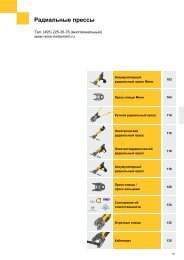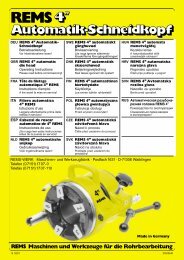Create successful ePaper yourself
Turn your PDF publications into a flip-book with our unique Google optimized e-Paper software.
GBR GBR<br />
Types of threads REMS REMS REMS<br />
External threads<br />
right- and left-hand<br />
Amigo Amigo 2 Amigo 2<br />
<strong>Compact</strong><br />
Pipe threads tapered<br />
Pipe threads parallel<br />
R (ISO 7-1, DIN 2999, BSPT) NPT<br />
(with button die) G (DIN ISO 228, DIN 259, BSPP) NPSM<br />
Threads for electric conduit<br />
Pipe threads parallel<br />
M×1.5 (DIN EN 60423, IEC)<br />
(with button die)<br />
Bolt threads<br />
Pg<br />
(with button die)<br />
Thread lengths<br />
M, BSW, UNC<br />
Pipe threads tapered<br />
Pipe threads parallel,<br />
standard length<br />
conduit, bolt 50 mm (with reclamping unlimited)<br />
Nipples and double-nipples with<br />
the REMS Nippelspanner<br />
(internal clamping) 3/8”–11/4” 1.3. Revolutions of die head<br />
Automatically, infinitely<br />
3/8”–2” 3/8”–2”<br />
variable rotation<br />
1.4. Electrical data<br />
230 V, 50–60 Hz<br />
35–27 rpm 30–18 rpm 30–18 rpm<br />
Power input 1200 W 1700 W 1200 W<br />
Rated current input 6 A 8,3 A 6 A<br />
Fuse protection 10 A (B) 16 A (B) 10 A (B)<br />
Intermittent service<br />
110 V, 50–60 Hz<br />
S3 20% S3 20% S3 20%<br />
Power input 1200 W 1700 W 1200 W<br />
Rated current input 12 A 16,6 A 12 A<br />
Fuse protection 20 A 30 A 20 A<br />
Intermittent service S3 20% S3 20% S3 20%<br />
When cutting taper threads the rated current may increase for a short<br />
moment by about 50 %, without interference of the function ot the unit.<br />
The drive units REMS Amigo and REMS Amigo 2 <strong>Compact</strong> are equipped<br />
with an overload protection which disconnects the motor when overloaded.<br />
In this case, press green button (10) on the motor handle. See<br />
also 6. Trouble.<br />
1.5. Dimensions REMS REMS REMS<br />
Amigo Amigo 2 Amigo 2<br />
<strong>Compact</strong><br />
440×85×195 mm 565×112×237 mm 500×90×215 mm<br />
17.3”×3.3”×7.7” 22.2”×4.4”×9.3” 19.7”×3.5”×8.5”<br />
1.6. Weights<br />
Drive unit 3.5 kg (7.7 lb) 6.5 kg (14.3 lb) 4.9 kg (10.8 lb)<br />
Support 1.3 kg (2.9 lb) 2.9 kg (6.4 lb) 2.6 kg (5.7 lb)<br />
Die heads 0.6 ... 0.8 kg 0.6 ... 1.3 kg 0.6 ... 1.3 kg<br />
1.7. Noise information<br />
Emission at<br />
1.3 ... 1.8 lb 1.3 ... 2.9 lb 1.3 ... 2.9 lb<br />
workplace<br />
1.8. Vibrations<br />
83 dB (A) 82 dB (A) 83 dB (A)<br />
Weighted effective value of<br />
acceleration 2.5 m/s2 2.5 m/s2 2.5 m/s2 2. Preparations for Use<br />
2.1. Electrical connection<br />
Before connecting the unit, check whether voltage on the rating plate<br />
matches the mains voltage.<br />
2.2. Tools<br />
Use only original quick-change die heads of REMS eva hand die stock.<br />
Up to 11 /4” diameter the die heads fit the octagonal seat from the front<br />
of the drive unit (Fig. 2). They snap-in automatically.<br />
The die heads protude the back of the housing. This facilitates taking<br />
the die head out of the drive unit by jolting the protuding edge against a<br />
plain surface or edge (fig. 3).<br />
When using the die heads 11/2 and 2” with the REMS Amigo 2 and REMS<br />
Amigo 2 <strong>Compact</strong> drive units, take off retaining ring (11) with a suitable<br />
tool, e. g. screwdriver. Remove stop ring (Fig. 4), insert 11/2” or 2” die<br />
head and replace ring (11). Do not work without retaining ring (11).<br />
Otherwise the die head may be pushed out, e.g. during start-cutting.<br />
Changing dies is necessary when the dies are used or worn or a thread<br />
is to be cut on a short piece of pipe. In both cases clamp the die head<br />
in a vice, remove cover, then carefully knock out dies from outside to in.<br />
Knock in new dies with the start-cutting edge pointing towards the bottom<br />
in corresponding slots (die 1 in slot 1, die 2 in slot 2, die 3 in slot 3,<br />
die 4 in slot 4) to the extent that they do not project beyond the housing.<br />
Install cover, lightly tighten screws. With a soft pin (copper, brass or hard<br />
wood) carefully knock out dies carefully outwards until they are in contact<br />
with the edge of the cover. Tighten screws securely.<br />
In case a thread is to be cut on a short piece of pipe, use REMS eva<br />
quick-change die head S with the additional pipe guidance on the cover<br />
side. These need to be operated from the cover side and have to be<br />
mounted the other way around. Therefore the dies are to be inserted<br />
with the start-cutting side pointing towards the top in following order: die<br />
1 in slot 1, die 2 in slot 4, die 3 in slot 3, die 4 in slot 2.<br />
2.3. Support bracket<br />
The support bracket (2) serves to support the die stock against torque<br />
in both directions, i. e. for advance and reverse rotation of the die head,<br />
for right and left hand threads. Support bracket must always be used!<br />
2.4. Thread-cutting oils<br />
Use only REMS thread-cutting oils. You will have perfect threading results,<br />
long durability of dies as well as high protection of the drive unit.<br />
REMS recommends the use of the practical and economical spray can.<br />
REMS Spezial: High-alloyed, mineral based hread-cutting oil. For all<br />
materials: steel, stainless steel, non-ferrous metals, plastics. Pleasant<br />
to work with. Washes out with water, approved by experts.<br />
Mineral based thread-cutting oils are not permitted for drinking water installations<br />
in some countries, e.g. Germany, Austria and Switzerland. In<br />
this case, use the mineral oil-free REMS Sanitol.<br />
REMS Sanitol: Mineral oil-free, synthetic thread-cutting oil for drinking<br />
water supplies. Completely water-soluable. Complies with regulations:<br />
in Germany DVGW Approval No. DW-0201AS2032, in Austria ÖVGW<br />
Approval No. W 1.303, in Switzerland SVGW Approval No. 7808-649.<br />
Viscosity at –10°C: 190 mPa s (cP). Pumpable to –28°C. No water added.<br />
Easy to use. Dyed red for rinse-out inspection.<br />
Both types of thread-cutting oils are available in spray cans as well as<br />
in cans and barrels.<br />
Use thread-cutting oils only undiluted!<br />
3. Operation<br />
3.1. Working procedure<br />
Cut pipe/rod at a right angle and burr-free. Fix the support bracket (2)<br />
about 10 cm (4”) from the end of the pipe (rod) by putting the support<br />
bracket from underneath against the pipe (rod) so that it is centered between<br />
the prism clamping jaw (3) and the feed screw (4). Tighten the<br />
feed screw. Spray REMS thread-cutting oil onto the threading section<br />
(see 2.2.). Insert the selected quick-change die head into the drive unit<br />
(Fig. 2). Put the unit on the pipe (rod) so that the motor housing (6) is<br />
placed inside the bracket. Adjust the ring switch (7) to the requested<br />
rotation (R for right hand threads or reverse rotation for left hand threads,<br />
L for left hand threads or reverse rotation for right hand threads). Press<br />
tip switch (8) while holding the motor handle (9). Press the gear handle<br />
(5) against the material. After 1 or 2 threads, the die heads continues to<br />
cut automatically. Lubricate several times with REMS Spray during threadcutting.<br />
The standard length for tapered threads is reached when the<br />
front edge of the pipe is flush with the upper edge of the dies (not top of<br />
the cover). When the desired thread length is reached, release the tip<br />
switch (8). When the unit stops rotating, turn the ring switch (7) into<br />
reverse and by pressing the tip switch (8) again the die head is running<br />
off the thread.




